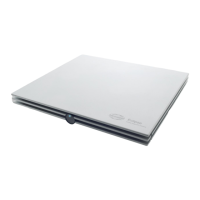Eclipse Additional Information Page 88
4.7 Technical details of the research module
For visualization of the recorded data there are important parameters to know and understand in order to
reestablish the EPx5 recordings in e.g. Excel and Matlab.
An overview of the most used parameters needed for extracting data from the research module are
Maximum voltage analog to
digital converter
16 bits constant number, means it can represent the data with ± 32768.
Typically 30.000Hz but depends on measurement type.
See string “SampleRate”
ABR15 sampling rate is 30kHz. Recording time 15ms.
ABR30 sampling rate is 15kHz, reduced a factor 2. Recording time 30ms.
VEMP sampling rate is 3kHz, reduced a factor 10. Recording time
150ms.
ALR sampling rate is 500Hz, reduced a factor 60. Recording time 900ms
Number of samples per curve
Typically 467, see string “NumberOfSamples”
Only 450 are displayed as 17 points are used for the filter algorithm.
See string “NumberOfMeasurements”
Please be informed when logging data that the exported data consist of
blocks, each holding 10 sweeps. E.g. 600 sweeps have been conducted,
you will see 60 logged data in the string.
For an exported session you will have one “block” which is the average of
all the sweeps.
See string “PrestimulusSamples” and “ScreenStartPos” and “ScreenEnd-
Pos”
The WAV files format must be 16bit using a sampling rate of 30kHz.
The maximum length of the WAV stimuli is 1.09227 sec.
Often set to 92dB, see string “Gain”
Number of measurements
Stimuli type
Frequency
Transducer
“NumberOfMeasurements”,
“StimuliType”,
“Frequency”
“Transducer”
The sampling rate of the Eclipse is 30 kHz with an Analog to Digital resolution of 16 bits.
The numbers of dots per trace is specified by the variable “NumberOfSamples” in the xml file, which is typi-
cally 467 dots displayed per trace.
If a fast stimuli rate has been used for the test, the number of dots per trace may be less, this means in other
words that the curve is getting shorter to maintain the high stimuli rate.

